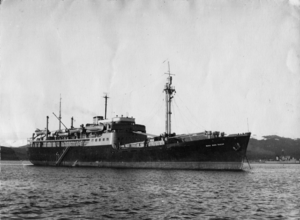ARA Bahía Buen Suceso facts for kids
 |
|
Quick facts for kids History |
|
|---|---|
| Name | Bahía Buen Suceso |
| Builder | Halifax Shipbuilding Ltd., Halifax, Nova Scotia |
| Yard number | 17 |
| Commissioned | 1950 |
| Identification |
|
| Fate | Sunk, 21 October 1982 |
| General characteristics | |
| Class and type | Bahía Aguirre class |
| Type | Transport |
| Tonnage | 3,834 gross register tons (GRT) |
| Length | 102.48 m (336 ft 3 in) |
| Beam | 14.36 m (47 ft 1 in) |
| Draught | 5.64 m (18 ft 6 in) |
| Propulsion | 2 × Nordberg 5-cylinder 3,750 hp (2,796 kW) diesel engines, 2 shafts |
| Speed | 14.5 knots (26.9 km/h; 16.7 mph) |
| Capacity | 100 passengers |
| Crew | 46 |
| Service record | |
| Part of: | Argentine Navy, Naval Transport Service |
| Operations: | Falklands war |
ARA Bahía Buen Suceso (B-6) was a large transport ship that served in the Argentine Navy for over 30 years. It was part of the Bahía Aguirre class of ships. From 1950 to 1982, it helped move supplies and people. The ship became well-known for its role in the Falklands War, where it delivered supplies to Argentine troops. It was captured by British forces in June 1982 and later sunk in October of the same year.
Contents
History of the Bahía Buen Suceso
The ship was built in Halifax, Nova Scotia, Canada, by Halifax Shipbuilding Limited. It officially joined the Argentine Navy in June 1950. The Bahía Buen Suceso was a busy ship. In 1958, it carried the crew for a new aircraft carrier called ARA Independencia all the way to the United Kingdom.
The ship also took part in many important trips to Antarctica. These missions helped supply the research bases there. In October 1966, the ship helped transport passengers and crew from a hijacked plane. The plane had been forced to land in the Falkland Islands by a group of Argentine nationalists. The Bahía Buen Suceso brought everyone safely back to Ushuaia, Argentina.
In March 1969, the ship made a long journey to Europe. It visited cities like Genova, Bruges, Rotterdam, Amsterdam, Portsmouth, Edinburgh, and Dublin. On this trip, it carried wheat to Europe and brought military items back to Argentina. While sailing through the English Channel, it had a small accident. It bumped into a tanker called Asprella. The Bahía Buen Suceso was then repaired at a shipyard in Vigo, Spain.
The Bahía Buen Suceso was often rented out to private companies. It usually sailed along the coast of southern Argentina. Each summer, it also took tourists on special trips to the Argentinian research bases in Antarctica. Starting in 1972, it began regular trips between the mainland and the Falkland Islands.
The Falklands War and the Ship's Role
The Bahía Buen Suceso played a key role at the start of the Falklands War. On March 19, 1982, it landed scrap-metal workers on South Georgia. This event was one of the first actions that led to the war.
During the war, the ship was used to bring supplies to the Falkland Islands. It sailed from Stanley on April 29, before the first British attacks began. On May 6, while sailing south, the ship found a small boat called Penelope. This boat belonged to the Falkland Islands Company and was anchored near Speedwell Island. The next day, an Argentine crew took control of the Penelope.
While the Bahía Buen Suceso was docked at Fox Bay East on West Falkland, it was attacked. Two British Sea Harrier jets from HMS Hermes flew over. Because the ship was very close to people's homes, the jets used their 30 mm cannons instead of bombs. They damaged the ship's bridge and engine room. They also caused a fire in a paint storage area and a workshop on shore. One of the Sea Harriers was hit by a small bullet in its tail during the attack, but it was able to return safely to its aircraft carrier.
After this attack, the Bahía Buen Suceso could not sail anymore. It stayed docked in Fox Bay East. During a storm, it partly broke free from its ropes, and its front part swung onto the beach. After the war ended, a tug called Irishman pulled the Bahía Buen Suceso to San Carlos Water. All the ammunition it was carrying was then unloaded.
The Ship's Final Moments
On October 21, 1982, the empty hull of the Bahía Buen Suceso was towed out to deep water. There, it was used for target practice by the Royal Navy. It was sunk by a combination of naval gunfire and attacks from Sea Harrier jets. The ship was also hit by a torpedo fired from the British submarine HMS Onyx.
See also
- List of auxiliary ships of the Argentine Navy

